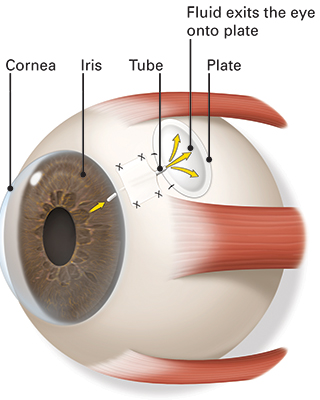What Is a Glaucoma Drainage Implant?
A glaucoma drainage implant is a small device placed in the eye to treat glaucoma.
With glaucoma, aqueous humor does not drain properly from the front of the eye. Pressure builds in the eye, which damages the optic nerve. If it is not treated, glaucoma leads to blindness. A drainage implant (also called an aqueous shunt or tube shunt) creates a new way for aqueous humor to drain from the eye. This helps to lower eye pressure.
Your ophthalmologist may recommend a drainage implant when eye drop medicine and laser treatments have not lowered your eye pressure enough. No treatment can fix the damage already done to the optic nerve. But drainage implants can help prevent further damage from glaucoma.
How Is Glaucoma Drainage Implant Surgery Performed?
Glaucoma drainage implant surgery is done in an outpatient surgery center or a hospital. The procedure usually takes about an hour or less. Here is what happens:
- You will be given an anesthesia to numb your eye area and medicine to help you relax.
- There are several types of glaucoma drainage implants. All have a soft, flexible tube connected to a small plate. That plate is very thin and curved to fit comfortably against your eyeball.
- Your eye surgeon will make a pocket under the clear conjunctiva. The plate will be placed in this pocket and sit on the sclera. The tiny tube that is attached to the plate will be inserted into the front part of your eye. Aqueous fluid flows out of your eye through this tube, lowering the eye pressure. The fluid collects in a pool over the plate (called a reservoir or bleb). That fluid is absorbed naturally by your body.
- After the procedure, your eye may be patched and you may need to wear the patch overnight. Plan to have someone drive you home after the surgery. Your vision may be blurry for several days to a few weeks.
- Your ophthalmologist will prescribe medicines to take for several weeks after the procedure. These medicines help prevent infection, discomfort and scarring.
- You should not bend over, strain or lift heavy objects as you recover. Your eye doctor will give you specific instructions and tell you when you can do these things again.
- Most people with a glaucoma drainage implant will need to continue taking some glaucoma medications. Your ophthalmologist will tell you which medications you should stop or continue.
- You will need to see your ophthalmologist a few times in the weeks after surgery for follow-up care. Be sure to keep these appointments.
What Are the Risks of Glaucoma Drainage Implant Surgery?
Like any surgery, glaucoma drainage implants carry the risk of problems or complications. Here are some of those risks:
- Scarring in or on the eyeball
- Infection in the eye
- Bleeding in the eye
- Too much fluid leaving the eye, making eye pressure too low
- Cataract (when the naturally clear lens in your eye gets cloudy)
- Corneal edema (swelling of the cornea at the front of the eye, which can cause blurry vision)
- Vision loss
- Double vision
- Need for a second glaucoma surgery or removal of the implant
Tell your ophthalmologist if you take aspirin or blood thinners. These can increase your risk of bleeding problems with surgery.
Call your ophthalmologist immediately if your eye is red, painful or just does not feel right. This could be a sign of infection and it must be treated right away.
Your ophthalmologist will talk with you about the risks and benefits of a drainage implant for your glaucoma.